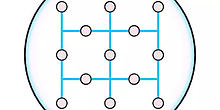 Image caption: Individual physical qubits, like rubidium atoms, are notoriously fragile and easily disturbed by interactions with their environment. To minimize errors, researchers entangle the atoms together to form a single "logical qubit,” which can be combined with other logical qubits into a fault-tolerant quantum circuit. Credit: S. Kelley/NIST
Image caption: Individual physical qubits, like rubidium atoms, are notoriously fragile and easily disturbed by interactions with their environment. To minimize errors, researchers entangle the atoms together to form a single "logical qubit,” which can be combined with other logical qubits into a fault-tolerant quantum circuit. Credit: S. Kelley/NIST
Researchers have created a prototype quantum computer with a record number of qubits—the analog of bits in an ordinary computer—capable of performing logical operations. The feat promises to be an important step toward building a practical quantum computer.
The work, led by scientists at Harvard University, included researchers from the Joint Center for Quantum Information and Computer Science (QuICS), the National Institute of Standards and Technology (NIST), the Massachusetts Institute of Technology and QuEra Computing Inc. in Boston.
For certain problems, quantum computing may offer an advantage over ordinary computing because qubits are not restricted to the specific “1’s” and “0’s” of ordinary bits, but can be in a superposition of the two, potentially storing and encoding much more information.
However, qubits are notoriously fragile, with their quantum states easily disturbed by interactions with their environment and prone to errors.
To minimize errors, the researchers used the principle of quantum entanglement, in which many physical qubits are linked together to form a “logical qubit” in which information is distributed among numerous qubits rather than stored in a single, potentially faulty one. In the team’s study, two closely spaced energy levels in single atoms of rubidium served as the physical qubits, which were moved around by laser light to associate with other qubits.
This entanglement strategy, known as a quantum error correction code, worked well in reducing errors. But it remained unclear how to best link groups of qubits in different ways.
That’s where quantum theorists Michael Gullans, a fellow in QuICS and a physicist at NIST, and Dominik Hangleiter, a QuICS Hartree Postdoctoral Fellow, came in. Experts in the theory of logical qubits and quantum algorithms, the two researchers created the choreography that combined and reshuffled logical qubits in complex ways so that they formed quantum circuits that could tackle certain kinds of computations.
“You could say we designed a dance, a new dance, for the individual qubits so they were able to perform new types of computations,” Gullans noted.
The dance enabled 228 individual qubits to form 48 logical qubits, the largest number of logical qubits in a quantum circuit to date.
“This will greatly accelerate the progress towards large-scale useful quantum computers and techniques,” said collaborator Dolev Bluvstein of Harvard.
The algorithm also provides a possible way to determine whether a particular operation performed on a quantum computer truly offers an advantage over an ordinary computer, Hangleiter said. Proving the so-called “quantum advantage” will be crucial to assessing progress.
The researchers described their work in an article posted in Nature on December 6. Additional details can be found in an article posted by Harvard University.